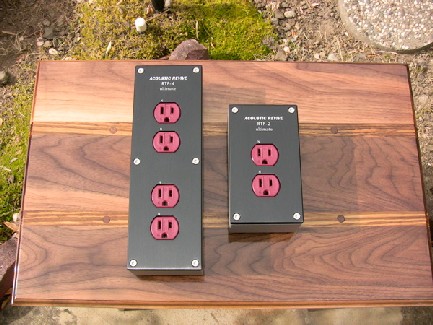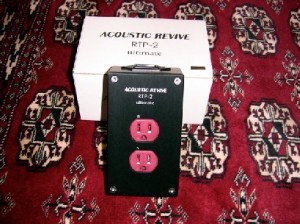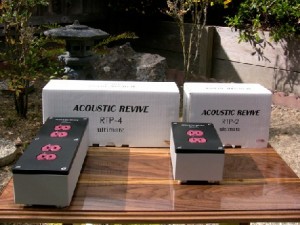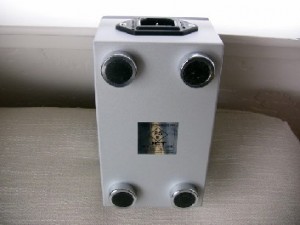Manufacturer:
- SEKIGUCHI MACHINE SALES CO., LTD
3016-1Tsunatori-machi, Isesaki-shi, Gunma Pref. 372-0812
JAPAN
US Distributor:
- The Lotus Group P.O. Box 1598,
Novato, CA 94945
Specs
- RTP-2 ultimate Power supply box comes with one receptacle to accommodate two pieces of audio gear
- Retail: $1295
- Optional: with attached power cord $1895
- RTP-4 ultimate Power supply box comes with two receptacles to accommodate four pieces of audio gear
- Retail: $2250
- RTP-6 ultimate Power supply box comes with three receptacles to accommodate six pieces of audio gear (not reviewed here) Retail $2775
Acoustic Revive is a very fitting name for this company. Now I did not ask them why they named it the way they did but it sure does seem to fit their persona. The word acoustic, in the musical context according to Wikipedia’s Online Dictionary, means the branch of acoustics that studies the physics of music. Revive, from the Merrian-Webster’s Online Dictionary, means to return to consciousness or life: become active or flourishing again. So we have a company whose name implies a scientific study of the physics of music that hopes to bring life back into our sound systems, or something along this nature. After reading their online website I don’t think this name was chosen by chance, in fact everything they do is carefully planned and very scientific, as you shall shortly see.
From the very first time I heard about Acoustic Revive and then looked at their website I knew I wanted to review their audio gear. Never before had I ever heard about a power supply box that looked this simple, so understated and yet was so complex and detailed in design. The RTP-2 ultimate is designed to take almost every conceivable problem into consideration and then solve it. At first you look at it and say, “Why $1295 for a power strip that can only handle two components?” After you read about what when into its construction and then try it in your system you might just wonder, “Why is it only $1295?”
RTP-2 and RTP-4 review and tests
To start out the RTP comes in three versions, the RTP-2, 4 and 6 ultimate. As the name implies the RTP-2 ultimate can be used for two pieces of equipment, the RTP-4 ultimate for four and finally the RTP-6 ultimate can handle six pieces. This is a very practical naming system, one that makes sense and easily identifies the purpose of each model. As you move up the model line you get bargain pricing because the RTP-6 is not three times the RTP-2 price.
Mr. Yoshi Hontani, the Managing Director, was kind enough to send me both an RTP-2 and RTP-4 ultimate for this review. Mr Hontani, Aki Monobe and Ken Ishiguro were my contacts and all were very gracious and accommodating in helping me pull my review together.
Right from the start I could tell this review would be fascinating. Go to their website and read the detailed product description of the thought process behind the RTP series and you will see what I mean. Acoustic Revive goes into a step-by-step process of how they made the RTP-2 (the RTP-4 & RTP-6 also being made the same way).
First they start with a solid block of 2017 Duralumin, with is then carved, out to make the chassis. 2017 Duralumin is an alloy made of about 95% aluminium, 4% copper and 1% manganese. They chose Duralumin because their research team has concluded it is best suited to producing good sound. The reason for making the chassis out of a solid block is to reduce vibration and distortion while increasing sound quality over the more commonly used process of bolting together metal sheets in order to form the box. This process of carving out a chassis and lid involves close to 5 hours for the RTP-2 and 8 hours for the RTP-4 and RTP-6.
They must be onto something with this 2017 Duralumin because I did a little research and discovered that the famous English guitar maker, Tony Zemaitis,used Duralumin in making some of his finest guitars. This man was a legend in his field, and he chose to use handcrafted solid Duralumin for the bridges and tailpieces of some of his metal front electric guitars. One such guitar, the Zemaitis Custom Shop MF500-LS had a list price of $12000. He believed these metal fronts reduced noise and hum as well as giving it a unique tone. Well who am I to disagree with someone like Tony Zemaitis or even Acoustic Revive, maybe Duralumin should be the alloy of choice for exceptional sound by everyone who is interested in proper acoustics.
Not stopping here, Acoustic Revive gets even more unusual in their design concept. Next they fill their power supply box with Green carborundum, Lithia Tourmaline powder and natural quartz powder to help eliminate both static and noise. Think about this now. No electrical components to break down or to add to the sound, just powder to naturally enhance the music. I like that organic approach, a very “greenish” design in today’s world where energy conservation is so important.
Under the chassis you will find four large brass carved out feet. Usually manufacturers will leave the feet to the consumer to buy aftermarket products, of which there are many, to improve upon their product but not with Acoustic Revive. Never one to miss anything, a vibration control sheet is placed under each foot. Professor Masao Sumita at the Tokyo Institute of Technology developed the material used under these feet.
Ok that’s it; I’m impressed, never had I heard of such technology going into such a little power supply box. We are not done yet though, as there are still more surprises ahead of us.
We still have yet to talk about the receptacles, which are Oyaide’s R-1 special version made from Beryllium copper. These were specifically chosen for their superior conductivity and then the electrodes surface was mirror polished for still even better conduct. Acoustic Revive even changed the electrode parts, to thick silver plating and a thick rhodium plating to achieve better conduct and phase characteristics. Most other manufacturers that Super cryogenically treat their receptacles do so to the entire receptacle. Acoustic Revive states that this process destroys the resin parts and then the sound quality will weaken, so they only treat the conduct parts.
Just like the receptacles the power supplies inlet is Super cryogenically treated. It is also treated with a thick silver and thick rhodium plating. Not to forget the inlet wiring connection, it is non-solder, as they feel solder destroys the transmission. Internal wiring is a very thick oval PCOCC-A type, made by Furukawa Electrical Industry. Again the choice here was for better conduct.
Finally, we arrive at the finishing touches to this unique product. Here let me just take a quote from the Acoustic Revive website, “To keep the product quality and sound quality in long term, the 2017 Duralumin made box is treated top quality pear surfaced Snow White Aumite, and lid is treated with top quality Black Hair Line finish. The brass foot is treated with top quality mirror surface finish Chrome plating. A product using non-surface treated Aluminum alloy and Brass releases rust which is harmful to human body, so please be careful. “
That afternoon when me younger son Joseph told me that a package had just arrived from Japan, I carefully unpacked it. Inside were two boxes, one smaller one for the RTP-2 ultimate and the other for the RTP-4. I was impressed at their beautiful physical appearance. Lifting them up they felt solid yet not so heavy that they could not be easily moved around with one hand. When I first put the RTP-2 into my main system I connected the Monarchy Audio DAC and the Sony DVP-7700 CD player (used as a transport) into its two outlets. I did not have the optional power cords that are available from Acoustic Revive on hand for review, so I used two inexpensive Monarchy Audio cords instead. These little power cords are 2 meters long and are overachievers at only $89 each. One cord went from the DAC to the RTP-2 and then another from the RTP-2 to the wall outlet. My Sony CD/DVD player sadly has a nonaudiophile nondetachable power cord that I plugged directly into the RTP-2. Ok, lets turn on the system and see what happens no break-in time needed here. Wait, did my wife surprise me? I know it’s a little more than a week until father’s day; did that little dear buy me a new CD player? Can’t be I would have seen it when I put on the CD. Did one of my audiophile buddies come by and sneak some new piece of gear into my system? No, same old system that I love, the only difference is that little RTP-2. Amazing!
I couldn’t wait; I had to try the RTP-2 with my Monarchy Audio SM-70 Pro amps (used in mono). For these I plugged my two Tek Line PC-8 Signature Power Cords from amps to RTP-2 and a Mr-Cable Musician power cord from the RTP-2 to the wall outlet. The PC-8 power cords list at $399 each while the Musician cord is $449 for 6’ lengths. I then used the RTP-4 for my CD player, DAC, preamp and phono stage with the Monarchy $89 power cord connecting it to the wall. Ok, now I have my system outfitted entirely with the RTP series power strips and I’m ready to go.
I first start out by playing a song from the movie Across the Universe, “Let It Be”, performed by Carol Woods and Timothy T. Mitchum. I know I have mentioned this song in a previous review, but right now it is high up on my list of vocal representation. Don’t worry though; new songs for review are on the horizon. My wife, Jennifer, was in the other room reading when I heard her comment, “Wow, that is so clear! Did those two little boxes do that?” Now please take note, equipment comes and goes in my room without hardly a nod from my wife so when she makes a statement like that a radical change must have taken place in order for her to comment. I am not yet doing my review, just being a kid again and listening to my tunes. About an hour goes by and I walk up to her and ask (even though I know the answer for me at least), “Was it that good?” ”Yes it was, you say they cost about $3600 for both?” “Yes but listen to the sound it’s wonderful” She doesn’t complain about the pricing, which is not normal for her, instead she only comments on its performance. I am stunned. She likes them and in her own way is saying they are worth the price. My wife is a tough audience and to win her over is a big accomplishment.
Ok, now I need to do some serious evaluating. I started out listening to a vinyl recording from the Muddy Waters album, Folk Singer, with a song titled “My Captain”. Right away you could hear the subtly in the guitars of Muddy and his young accomplice Buddy Guy. Buddy of course later went on to be quite famous in his own right. With the help of the RTP series you could hear the distinct characteristics of Muddy Waters unique vocal tones and enjoy his own down to earth style of singer. I heard his voice go from soft to very loud and then quickly back down again. The RTP’s held nothing back and you could hear it all. The difference with the RTP’s in my system was that the performance was layered not flat. You did not get that clear yet compressed sound that plagues equipment of a much lesser stature.
Listening to Traffic’s, The Low Spark of High Heeled Boys vinyl album, I was taken by the song “Rainmaker”. Once again the RTP-2 and RTP-4 took my system to a new level with a wonderful 3-dimensional flute solo in the beginning of the song. There was one part in particular were the voice just hung in the air of a dead silent background. Part of this, of course, was the recording and the musical arrangement while the rest was the result of Acoustic Revive’s RTP series. I had heard these albums many times over and never did they sound so multi-dimensional as the RTP’s have made them.
Of course you cannot listen to vinyl without a little help from our friends, The Beatles. Their Abbey Road album has a song entitled, “Come Together” which says:
“One thing i can tell you is you got to be free Come together right now over me”
Well that is what the RTP ultimate series will do for you. If you want to be free to hear the true musical experience all you have got to do is come put all your power cords together over the RTP of your choice.
Moving onto my CD collection I must tell you that the RTP’s brought CD’s much closer to the sound of vinyl. Both mediums being different of course they will never be the same but I was enjoying my CD collection on a level I never felt before. I have been researching to buy a new CD player, feeling that it is my weakest link, only to discover it really was my power supplies that needed improvement.
Starting out with selections from Leo Sayer’s, “Leo Sayer Live”, CD I started with one of my favorites “When I Need You”. Definitely a song to be listened to with someone you care for and not just by yourself. If you are not familiar with Leo you will remember his many hit songs shortly after you play any of his CD’s. I have talked to a few people who have said, “Oh is that Leo Sayer!” after I played a few pieces for them. One such song is “You Make Me Feel Like Dancing”; they all remembered that popular song. Being a CD recorded at live concerts the RTP’s allowed one to hear all those background details from the audience, at the concert, that gave you that live I am there feeling.
Getting the size and sound of a piano correct in your home environment is close to impossible. Trying to create the illusion that a large grand piano is right in front of you is not an easy task. Acoustic Revive did a great job with the Philip Glass, “Solo Piano” CD in that it took my other equipment as far as it could go towards that end. That really is all you could expect it to do. Once again another find effort from the RTP’s.
Now onto the last two CD selections, first being, The Romantic Violin with a selection of Felix Mendelssohn-Bartholody Violin Concerto NO. 1 in E minor op. 64. Here we can experience violins that are neither shrill nor irrating but rather fullbodied while still being fast and clear. Which brings me to the final CD by Jerry Garcia called Shady Grove. “The Sweat Sunny South”, performed by the combination of David Grisman and Jerry Garcia on five-string banjos captures the fast and lightening quick picking of these two greats, wow! The RPT’s just seems to add something to these two greats playing banjo that I did not feel before without them in my system.
I know that some of what I have said about the RTP series sounds repetitious but that is only because I couldn’t find fault in this product. There were songs that I played and did not like, but that was through no fault of the RTP-2 or 4 ultimates, unless you can blame it for exposing the weaknesses in the performers or recording.
In the end I can only say that before you even think of upgrading your system you must try one or two of these power strips by Acoustic Revive. My already good system went through a major transformation with their addition. This is not one of those “tweaks” that you put into your system and then you try to convince yourself you are hearing something for the better. No, this is some very serious equipment that the collective genius of many individuals collaborated on to produce. Start out with the RTP-2 ultimate if you like and add an inexpensive power cord to plug it into the wall sock. For $1295 plus $89 for the power cord you have $1384 invested and you can plug in your CD player and one power source to start you off. Do keep in mind that even though you can use an $89 power cord and still get great sound, the RTP series gets even better if you spend your money wisely on a better power cord. Right now I am using an older PS Audio Lab II power cord with excellent results and I plan on trying even more cords shortly. You would be much better to go with an integrated amp, saving money over separates, and use the savings to purchase the RTP-2. You already own separates, great, and then the choice is to go with first one RTP-2 and later add another or to take the savings now by buying the RTP-4 or even the RTP-6. Doing this not only are you saving when you buy the larger models but now you spend less on additional power cords as well. The savings just keep adding up. There is no doubt in my mind; the RTP-2 and RTP-4 are a bargain in the world of escalating high-end audio prices where you don’t have to look to hard to find just a stereo cartridge alone selling for $5000. The best thing you could do is to arrange with your dealer for either a home audition or to give you a week to upgrade the RTP-2 for the RTP-4 or even the RTP-6. Once in your home I think you will find, like I did, getting hooked on having them in your system is a very simple matter indeed.
The great thing about the RTP ultimates, no matter which one you get, is that once purchased you can forget about that link in your audio system. Unless you need more outlets later on this is about as good as it gets. No matter what type of music I listened to the RTP’s improved upon it to the point that even non-audiophiles could readily hear the difference. Plug in your CD player, DAC, Amps phono stage or whatever you need to and experience a true upgrade in performance that will forever change your view of power supplies.
One other thing worth mentioning is the grip that the ”Ultimates” have on power cords. I felt like Superman had a hold of my sturdy Tek Line power cords and removing them from the RTP-2 was no easy task. This however is a good thing in that it is doing the job it was designed for. It locks in with a super-firm grip on your components and your music systems in order to provide you with a connection to your music you will not soon forget.
The Research team at Acoustic Research has spared no expense in bringing us a product so thoughtfully planed out and designed that I can see no weaknesses in any aspect of their product. If this is an example of how through research and development they market their products then I hope to review more of them in the future. Right now I have my eye on their RD-3 Disc Demagnetizer for only $399.
I will leave you with this quote from their website where Acoustic Revive has this to say about their RTP ultimate series,
“The last evolution power supply box which is made in total luxury! The real ultimate!”
The listening environment:
My listening room is 18’ 8” long by 13’ wide. The room’s cathedral ceiling starts at 8’ high then slopes upward to 13’ at its peak in the middle. Flooring is a soft hardwood covering with an oriental rug placed dead center in between (but not under) the listener and the audio system. All surfaces are left untreated and there are no doors that open or shut into other rooms.
Review equipment:
- Dignity Audio DA08SE integrated mono amps (imported by Monarchy Audio) Monarchy Audio SM-70 Pro Amps (run in mono)
- Placette Passive Preamp (3 input model)
- Oracle Delphi Mk I turntable with custom made interconnects
- Grace 707 tonearm with Denon 301 II MC cartridge
- Whest PhonoStage.20 + MsU.20 power supply
- Sony DVP-S7700 CD/DVD Player (used as transport only)
- Monarchy Audio Dual 20-Bit D/A Converter (modified by Monarchy Audio) Legacy Focus 20/20 speakers
- Monster HTS-2000 Power Conditioner
- PS Audio UPC-200 Power Center
- PS Audio Power Port Receptacle
- Blue Circle BC86 MKIII power line pillows (2) Anti-Cable speaker wire 10’ pair
- Anti-Jumpers for Legacy speakers
- Anti-IC’s (2 pairs)
- PS Audio Transcendent Interconnects (solid silver series) from the xStream Audio Series
- PS Audio Lab Cable II one-meter length
- Tek Line TL 500-S (silver interconnects)
- Tek Line PC-8 Signature Power Cords (2) 6’ lengths
- Mr-Cable Musician power cord 9’ length Black Diamond Racing Cones (#3 & #4) Audio Prism IsoBearing (Isolation Globes)
from affordableaudio, By Anthony Nicosia



